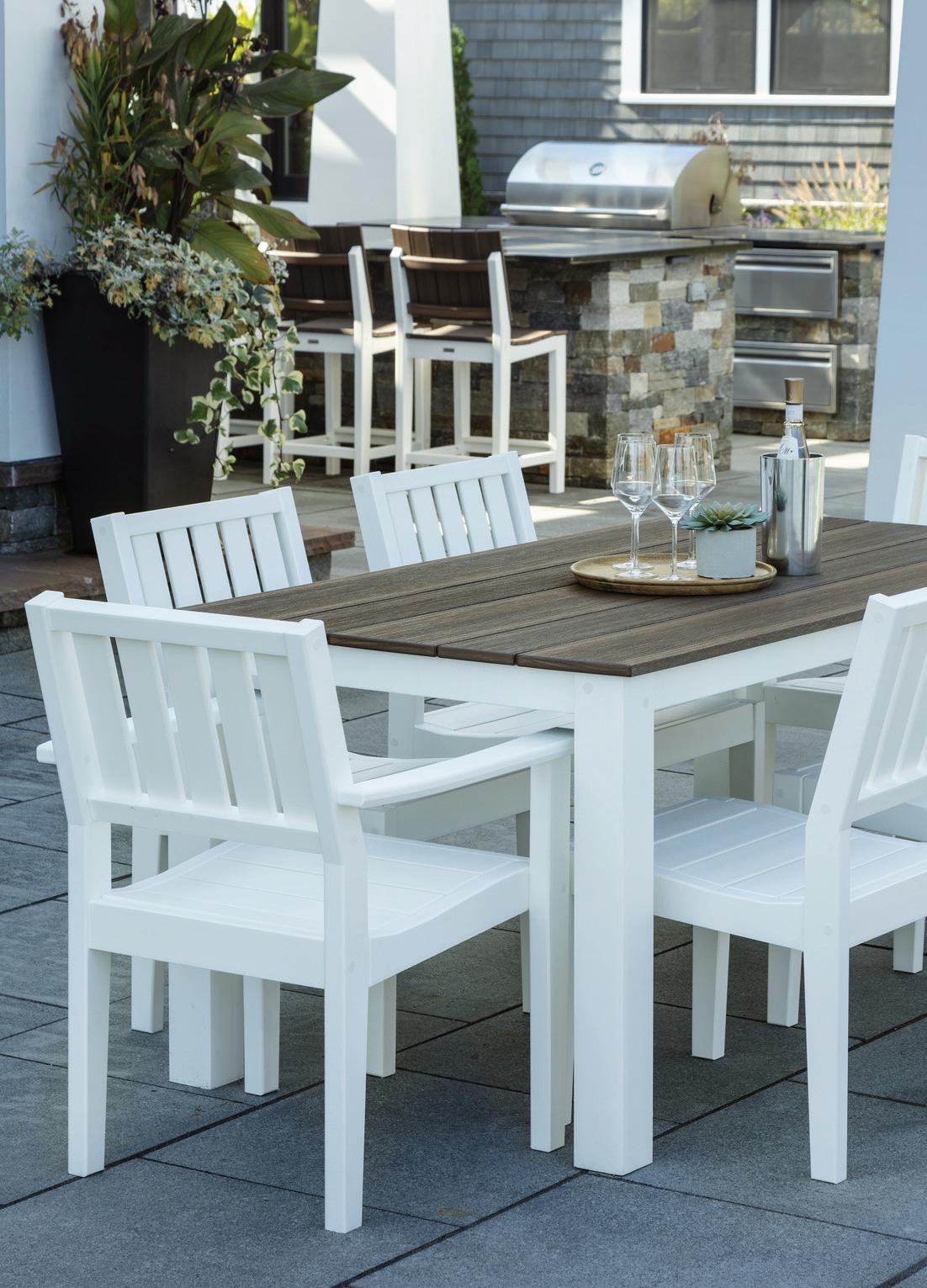
18 minute read
Easton Map and History

The County Seat of Talbot County. Established around early religious settlements and a court of law, Historic Downtown Easton is today a centerpiece of fine specialty shops, business and cultural activities, unique restaurants, and architectural fascination. Treelined streets are graced with various period structures and remarkable homes, carefully preserved or restored. Because of its historical significance, historic Easton has earned © John Norton distinction as the “Colonial Capitol of the Eastern Shore” and was honored as number eight in the book “The 100 Best Small Towns in America.” With a population of over 16,500, Easton offers the best of many worlds including access to large metropolitan areas like Baltimore, Annapolis, Washington, and Wilmington. For a walking tour and more history visit https:// tidewatertimes.com/travel-tourism/easton-maryland/.



Joseph and Mary E. Caulk
where on schooners that could pull right up to the farm wharves. Not to mention the added opportunities for fi shing and oystering.
To make the purchase, Joseph borrowed $5,000 from his father, Major William Caulk, of Lostock farm in Bozman. Although Lostock had been the Caulk family homestead since 1705, legend has it that Major William was motivated to get his son Joseph removed some distance away from the clutches of Mary Elizabeth Haddaway, whom he disapproved of for some reason, so a farm all the way across the county in Trappe seemed perfect. And for this, Joseph was to pay his father $500 a


year on the loan. Not counting the seven slaves needed, which were $500 extra.
Joseph had only made one partial payment of $225 on the loan when William died in 1841. So Joseph got the farm and then, perhaps to no one’s surprise, got the lady, too, when he married Mary Elizabeth Haddaway in 1842. Apparently Trappe wasn’t far enough away after all to be out of the reach of true love.
It is said that Isle of Rays got its name from the way the rays of the morning sun slanted through the trees and across the lane, but the name could also have been inspired by Maria Southworth’s best-selling 1851 novel The Mother-in-Law: Or, The Isle of Rays, which has vivid descriptions of sunlight reflecting on water and trees on an island farm. Perhaps someone in the family had read that book.
Joseph died in 1858 and was buried in the back lawn with a great view of the water. In 1866, Mary Elizabeth planned to split the farm between her two sons, William H. and John K.
William H., being the first born, would get the better half, with the brick manor house that Joseph built in 1845 using bricks made on the property. The hole from which the clay was dug was visible for many years.
When Mary Elizabeth died in 1868, the farm was divided. However, when the unmarried William H. died unexpectedly of typhoid 47
Call For Availability
Farming in Talbot County which sale was so noteworthy that it was mentioned in John K.’s obituary fever in 1870, his younger brother, when he died in 1913. John K., inherited William’s half and Mary S.E. Caulk died in 1926 and the farm was complete again. left each of her five children equal
John Kersey Caulk married Mary shares of her farms. Three of her Susan Elizabeth Caulk, and they had children, Owen, Elizabeth “Bess” five children. Mary S.E. Caulk was and Sallie, who were living on Isle his first cousin. Curiously, marry- of Rays, bought out the shares from ing one’s first cousin wasn’t all that their two siblings, and Owen ran the unusual on the Eastern Shore then farms until his death in 1931, when and may help explain some of the ec- Bess and Sallie took over the mancentricities found among the natives. agement of Isle of Rays, the neigh-
Besides farming, John K. special- boring Milan Farm, which Owen had ized in raising high-grade Jersey purchased in 1910, and the original cattle and prize-winning trotting Lostock farm, which was a notable horses. He sold one horse, Phil accomplishment for two women in Daugherty, winner of many races at the days when farming was, and still the Talbot County Fair, for $2,200, is, male oriented.

Farming in Talbot County Centreville and was featured in the following fl owery ad in the May issue
This fi nally brings us up to 1936, of Country Life Magazine, when the management of 800 acres was getting to be too much for the “THE EASTERN SHORE of MARYtwo single ladies, so they wanted to LAND downsize, sell Isle of Rays with its Waterfront Estate big house, pay off the two mortgages “This beautiful brick Georgian Owen had taken out and buy a small mansion surrounded by large trees house in Trappe. stands in the midst of a lawn which
By now, waterfront property was runs down to the shores of a lovely being appreciated for its aesthetic river. In addition the property inreasons by rich come-here from out cludes from 300 to 500 acres of fertile of state who were buying up beautiful estates from the now land-rich and cash-strapped former gentry who couldn’t maintain them, especially in the Depression years.
Isle of Rays was listed for sale by the Eastern Shore Estates Co. of


farm land. The soundest and safest investment in America today. One which every member of the family can enjoy.
EASTERN SHORE ESTATES CO. Centreville
Queen Anne’s County - Maryland Booklet “OLD HOMES ON DEEP
RIVERS” sent on request.”
The accompanying photo showed that Isle of Rays’ house was completely covered by ivy, except for the roof and areas cut out for the doors and windows!
This ad was seen by Bertram Voshell of Orange, N.J., who worked for what is now Mobil Oil in their New York office, which prompted these fascinating letters from the Caulk sisters, excerpts from which follow. My comments and additions are in brackets,
Feb. 4, 1936
Dear Mr. Voshell,
Your letter received. There are around two hundred seventy five acres [the acreage was actually 339] and about two hundred in cultivation. We have found a diversified cultivation of cropping system is the best therefore along with wheat, corn, peas and tomatoes. We raise cows, sheep and pigs also chickens and turkeys.
This is an excellent stock farm.
Peas have paid well grown for the canners and they also build up the soil. We raise about a ton to the acre
Sue Sterling’s Hair Studio, Inc
Hair Color Correction

Fade too fast? Too ashy, golden, red? Need Natural White or Gray Softened? White Roots Appear Too Fast! Stain on Skin at Hairline! Bad Color for You!

Don’t be “That Girl” - Let Us Help!
Contact Sue Sterling for a Free Consultation! 105 Federal St., Ste. A, Easton ◆ 410-822-6777
which is a good crop and after the peas are off put the same land back in corn thereby raising two crops on the same land the same year. Tomatoes yield well about ten tons to the acre. When tomatoes were a good price my brother’s check was six thousand dollars for one year on twenty five acres. Corn yields around forty bushels to the acre and wheat twenty to twenty five bushels to the acre. I am sure that the money invested in this farm will pay good interest as well as a good living.
One of our neighbors told me yesterday that his farm paid him well.

Bess Caulk drew a map of Isle of Rays in 1936. He farms his land but lives in the village and has a hired man on the place. On the right side our neighbor rents his place on shares and he is well pleased with the result.
We plant our own seed wheat and seed corn and we buy clover seed. We planted $25 worth last spring. Two years ago we planted alfalfa for hay and that will last several more years. We have 18 acres and cut it four times last year. We have already about thirty five acres plowed last fall for tomatoes, but peas and sweet corn in the spring.
We hire two men for fifteen dollars a month. They also get their house and firewood on the place. Three hundred pounds of hog meat per year and six barrels of flour a year. The wheat we take to the local mill and have their flour ground also the hogs are raised on the place for their allowance. When we have to have daily help to get off the wheat, corn and hay we pay from one dollar a day to a dollar fifty.
The taxes on the place are about $234.00. Ours are paid up until next August when we get a discount.
There are two houses for the hired men on the place and also a stable and shed extra across the field where we keep sheep. I enclose the drawing I made. If there is anything else you do not understand I will answer any question to the best of my ability and if at anytime you wish to come down if you will let us know a day or so before you can come we will be here








Farming in Talbot County New York City, My sister and I have talked over to show you around. [Elizabeth’s your plans of renting the place and drawing was a map showing the we both think that we cannot do that locations of the various crops and because we might lose the chance of the woodland.] a sale of the property from someone
There are several beautiful sites who may want a farm such as ours. for building on the farm and the We do know of a man about thirty farm could easily be divided into six years old and his wife they have two smaller farms if you wanted two little boys. They are thoroughly to sell part. reliable and dependable… They Very sincerely would do anything you wish and Elizabeth Caulk would take care of the place in every Trappe way and I am sure you would be Talbot Co. delighted with the result… Maryland We could promise also to look
We own the farm next to this one. out for things here in your absence April 13, 1936 as far as lay in our power so you Dear Mr. Voshell, would not need to be worried about

that what is happening when you are not here and I am sure that the proceeds of our farming would pay all expenses. I am sorry I could not give you an account of the proceeds of our farming but we have carried on these 800 acres [in three farms] as one farm. My sister has just looked over the amounts we took in last year and it amounts to around six thousand. When my brother was living his peas amounted to four thousand. You cannot always know what your intake may be.
Down here the farmers generally help each other in busy seasons and we could help your men and yours could help ours. The advantages of having a place the size of this farm is that you can raise enough produce to pay the expenses but on a small farm the production is so little that it does not quite amount to enough to pay expenses. The roads have greatly improved since your visit and today is a good drying day. We hope to get some oyster shells and scrape our road. We surely did enjoy your visit last Saturday. Please give our kind regards to Mrs. Voshell and tell her now is the time to start her fl ower garden.
very sincerely Elizabeth Caulk
“Isle of Rays”
Aug. 7, 1936
My dear Mrs. Voshell, ....We have 800 acres of land and

Farming in Talbot County Coronation? [of George VI] Sincerely we feel if we sell one of our three Elizabeth Caulk farms we can make the other two more valuable. We expect to put in a October 12, 1937 telephone at Isle of Rays as soon as Dear Mr. Voshell, we can get the poles cut and set up but I have just received your letters next week we have a very good crop and the map for which I thank you. of sugar corn that we have to get off. [Apparently, Bess had asked for the Sincerely letters to be returned, which accountSallie B. Caulk ed for them still being in her desk]. We are trying very hard at the May 28, 1937 present time to get the wheat planted Dear Mrs. Voshell, and if this good weather keeps up I
We were glad to get your letter believe we can soon get through… and have intended writing to you We do not plan to cut any trees before this and telling you to come until we get all the farm work done down anytime you would like and and Sam did say our woods would bring your brother. The place looks be all right but I was afraid he might very lovely just now. We had a lot of be mistaken. We cannot start to build rain last night and everything looks until sometime in the spring anyway. like it had been washed. We have a As for the Kersey blood you have telephone now and our number is just as much in you as I have. [CuTrappe 340 so if you happen to be riously, the middle names of both down this way just call us up. Voshell’s and Elizabeth’s fathers was
We are getting ready to put down Kersey]. I have a piece to read you a little wharf and I have just finished about them when you come. painting my boat. Please give us a little notice before
We have been wondering if you you come if possible. Sam [one of the and Mr. Voshell had gone to the hired men] wants to smooth the road up a little and we might be out somewhere. You will have to have a key so you can get in anytime. It’s beautiful here today I wish you could see it. I am glad Mrs. Voshell arrived safely and sorry she can’t go to the Sale with us on Thursday. Very sincerely Elizabeth Caulk [The Voshells bought Isle of Rays

Farming in Talbot County lane has been splendid all winter. I certainly hope the electrical on Dec. 2, 1937, taking a $21,000 current will not cost much to install. mortgage from the Caulks as part of I do not believe it will if we can the purchase price.] prevail against Mr. Spring who is now in Florida according to the December 15, 1937 Star-Democrat. I have written to Mr. Dear Owners of Isle of Rays, German to about putting it across
How do? It hasn’t snowed yet, but from Stevenson’s to the Point Field... it sure does look like it won’t be long. Your bulbs are coming up around We haven’t had any zero weather ei- the front of the house. They look nice ther. Sallie and I went to Cambridge and green. I surely hope and pray yesterday to do some shopping and that you will be very happy here. get some flour from the mill and we With best wishes went to Easton on Saturday the 10th Sincerely and pay the interest on the mortgage Bess Caulk which I know you will be glad for you didn’t know what would happen if My friend Holly Eliot, who manwe didn’t. ages several thousand acres of her …I believe everything is all set family’s farms in the Midwest, has for a happy Christmas and look out the following 21st-century take on for the turkey and hope to get off the Caulks’ farming letters, the first of the week. We decided as “This is very interesting! It does long as you couldn’t come here that appear that crops were more diversithe big bird had best go to Orange fied back then. Elizabeth mentions and we hope you all will have a very ‘the canners’ taking the peas, and I’m joyful time. guessing the tomatoes, too, since she Sincerely gives the yields in tons. I wonder if E.C. the cannery industry is still in business on the Eastern Shore? [No, the Feb. 8, 1938 canneries are long gone, for the most My dear Mrs. Voshell, part. J.D.] ... it’s perfectly beautiful weather “I think it’s marvelous that they today. We worked the road up early could get two full crops in one year! yesterday morning that is we ran I don’t have experience with fresh the logs over it and smoothed out green peas, which would obviously the rougher places. Sallie says if we be harvested earlier than dried soycould jump from one piece of gravel beans, but it’s cool that they could road to the other we would be all harvest them and then plant a new right. The county road as far as the crop of corn the same summer. Also 60
it’s interesting that they recognized that legumes ‘build up the soil.’
“I’m impressed that two hired men could do all the work on all those diff erent crops, haul the wheat to a mill, etc. But then again 275 acres is not that huge a farm. In those days, and even in my grandpa’s day, 200 acres could feed a family. Elizabeth says the investment would pay ‘good interest as well as a good living.’ Not anymore…
“Yields have changed, too. Wheat yields have doubled, to around 40 bushels per acre, but corn yields have grown 4-5 times, to anywhere from 180 to 225 bushels or more per acre. And another thing - people don’t save their own grain for seed anymore, mostly because it would be a patent infringement. Isn’t that crazy?…
“I love the account of how they had to drag a log over the road to smooth it, and the slow advance of telephone and electricity wires. It sure must have been a beautiful peninsula back then!”
The Voshells lived at Isle of Rays for many happy years, fi nally selling it in 1960 to a new owner who changed its name to Roslyn. It was briefl y run as a horse farm, then has since been sold several times and subdivided.
Without a doubt, despite the name change, the morning sun still slants through the trees and across the lane just like it did over 150 years ago.
just like it did over 150 years ago.
James Dawson is the owner of Unicorn Bookshop in Trappe.
Pamela P. Gardner, AIA, LLC

311 N. Aurora St., Easton · 410-820-7973 · pam@ppgaia.com www.pamelagardneraia.com
Queen Anne’s County
The history of Queen Anne’s County dates back to the earliest Colonial settlements in Maryland. Small hamlets began appearing in the northern portion of the county in the 1600s. Early communities grew up around transportation routes, the rivers and streams, and then roads and eventually railroads. Small towns were centers of economic and social activity and evolved over the years from thriving centers of tobacco trade to communities boosted by the railroad boom.
Queenstown was the original county seat when Queen Anne’s County was created in 1706, but that designation was passed on to Centreville in 1782. It’s location was important during the 18th century, because it is near a creek that, during that time, could be navigated by tradesmen. A hub for shipping and receiving, Queenstown was attacked by English troops during the War of 1812.
Construction of the Federal-style courthouse in Centreville began in 1791 and is the oldest courthouse in continuous use in the state of Maryland. Today, Centreville is the largest town in Queen Anne’s County. With its relaxed lifestyle and tree-lined streets, it is a classic example of small town America.
The Stevensville Historic District, also known as Historic Stevensville, is a national historic district in downtown Stevensville, Queen Anne’s County. It contains roughly 100 historic structures, and is listed on the National Register of Historic Places. It is located primarily along East Main Street, a portion of Love Point Road, and a former section of Cockey Lane.
The Chesapeake Heritage and Visitor Center in Chester at Kent Narrows provides and overview of the Chesapeake region’s heritage, resources and culture. The Chesapeake Heritage and Visitor Center serves as Queen Anne’s County’s official welcome center.
Queen Anne’s County is also home to the Chesapeake Bay Environmental Center (formerly Horsehead Wetland Center), located in Grasonville. The CBEC is a 500-acre preserve just 15 minutes from the Chesapeake Bay Bridge. Over 200 species of birds have been recorded in the area.
Embraced by miles of scenic Chesapeake Bay waterways and graced with acres of pastoral rural landscape, Queen Anne’s County offers a relaxing environment for visitors and locals alike.
For more information about Queen Anne’s County, visit www.qac.org.










